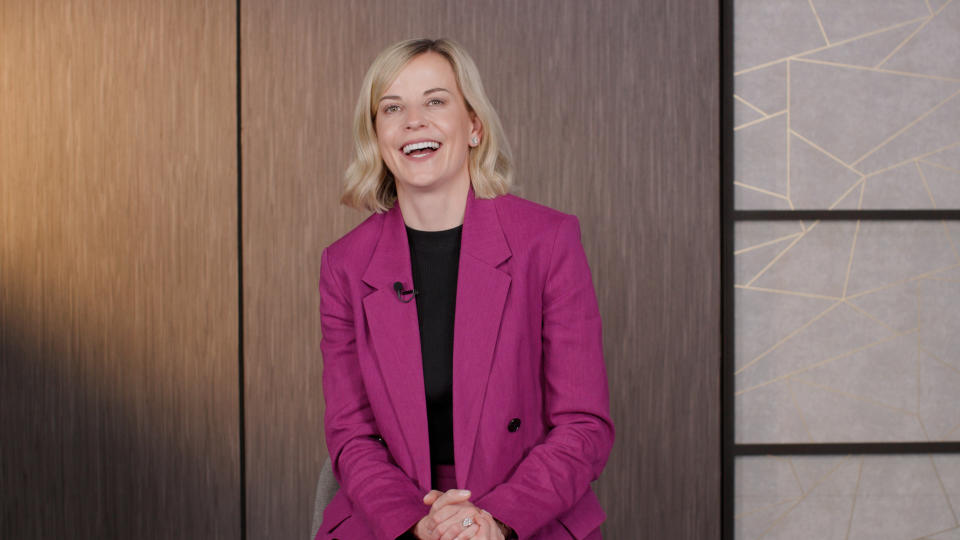F1 Academy’s managing director brings a full-throttle mentality to her race-day routine—which usually has no breaks: ‘I’m pretty good at running on adrenaline’

As a former racing driver, F1 Academy managing director Susie Wolff doesn’t like moving slowly.
“I'm not someone that needs lots of breaks,” she told Fortune. “I certainly feel at the end of the day that I can't speak any more because I've normally spoken throughout the whole weekend and I can't really bear to hear my own voice anymore. But generally, I'm pretty good at running on adrenaline.”
F1 Academy, an all-women racing series in its second year, globe-trots across seven circuits alongside Formula 1. Its 15 drivers are up-and-coming racers, who, like Wolff, began their careers in karts, and have their sights set on lifting the F1 World Championship trophy one day.
F1 has boomed in the U.S. as a result of its 2017 acquisition by Liberty Media and its hit Netflix docu-series Drive To Survive, which has garnered the attention of 7 million global viewers. As its popularity grows, so, too, does the diversity of its audience. According to F1 CEO Stefano Domincali, 40% of F1’s fanbase are women—despite the sport having no women drivers.
Wolff and F1 Academy are working to rectify that by serving as a pipeline to bring more women into the sport to climb the ranks and one day compete in F1. Wolff, a self-proclaimed optimist, believes there will be a woman driver in the so-called pinnacle of motorsport in the next five or six years.
It’s a massive undertaking. And this weekend, as F1 Academy travels to Barcelona for its third race of the season—the F1 grand prix weekend was attended by over 280,000 people last year—Wolff’s busy schedule will reflect that.
Wolff shared an inside look at her bumper-to-bumper days of race weekends with Fortune ahead of F1 Academy’s race weekend, which runs from June 21 to 23.
Pedal to the metal
6:00 a.m.: An early riser, Wolff begins her day with a coffee, but no breakfast. She leans on the support of sponsors Tommy Hilfiger and Charlotte Tilbury for her get-ready routine, which includes a team kit courtesy of the American outfitter—and an eight-minute makeup routine.
“You can tell I like to do everything with speed,” she said.
10:00 a.m.: Wolff then heads to the race track up to six hours before the starting lights activate. Between meetings and a team lunch at the paddock’s hospitality building, she makes her way to the track to ensure things are running smoothly before the weekend’s events.
“I always like to go down and see the cars go into the garage,” Wolff said. “You see all the teams and just make sure that everything feels like it's in a good place before everyone heads to the grid for the race.”
Wolff gets better than a front-row seat for the races: She watches cars zoom by from the pitlane, alternating which team’s garage she stands in front of based on “whichever team feels right in that moment.”
Another pitlane perk is the short walk from there to the podium ceremony, where the top-three racers lift their trophies and spray champagne.
“That's one of the best parts of the day,” she said. “Obviously, the brutality of sport is only ever one winner, but that winner and that team are normally very, very happy, and it's nice to be around them and to feel their enthusiasm and positivity after the race.”
10:00 p.m.: “The minute I leave the racetrack, and my adrenaline levels drop, that's when I realized just how exhausted I am,” Wolff said.
Immediately following the last race of the weekend, Wolff packs up her belongings and drives to the airport, where she and her husband, Toto, the team principal of the Mercedes F1 Team, fly home to see their young son.
Wolff winds down after dinner, trying to squeeze in a couple pages of a book before going to sleep by 11 p.m.
“I'm normally in bed pretty early because I know if I've made it home, that I have to get up around 6:30 to do the school run the next day,” she said.
It’s rinse and repeat for Wolff, who travels seven to 10 days of the month. With so many flights across the world, Wolff tries to maintain a delicate sleeping equilibrium. She recalled a particularly brutal trip last year from Las Vegas to Abu Dhabi for the F1 season’s final two grands prix. It took her 10 days to adjust back to normal sleeping patterns after braving the 12-hour time difference.
“It's actually just best to sleep when you can, as opposed to trying to be too rigorous on a jet lag plan,” she said. “Obviously, not driving anymore means I don't need to be at my absolute peak performance. I actually just need to make sure that I'm capable of doing meetings and of making good decisions when I'm at the racetrack.”
Wolff stays active through frequent pilates and games of padel, a relative of pickleball popular among F1 drivers, particularly those in Monaco. As with sleep, she tries to find moments to exercise when she can without being too rigid in her routines.
“I simply try and do what I can when I can,” Wolff said, “And don't beat myself up if I don't make every last set or every last expectation I put on myself.”
This story was originally featured on Fortune.com

 Yahoo Finance
Yahoo Finance 